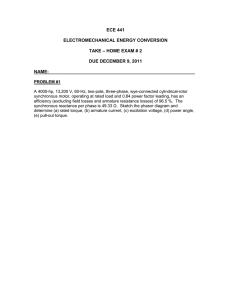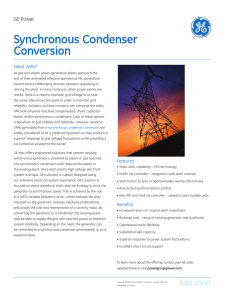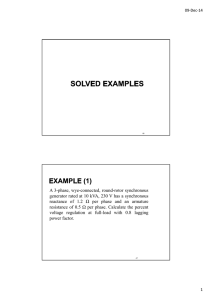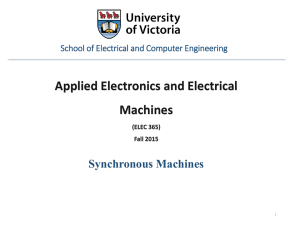Synchronous Machine exercises
advertisement
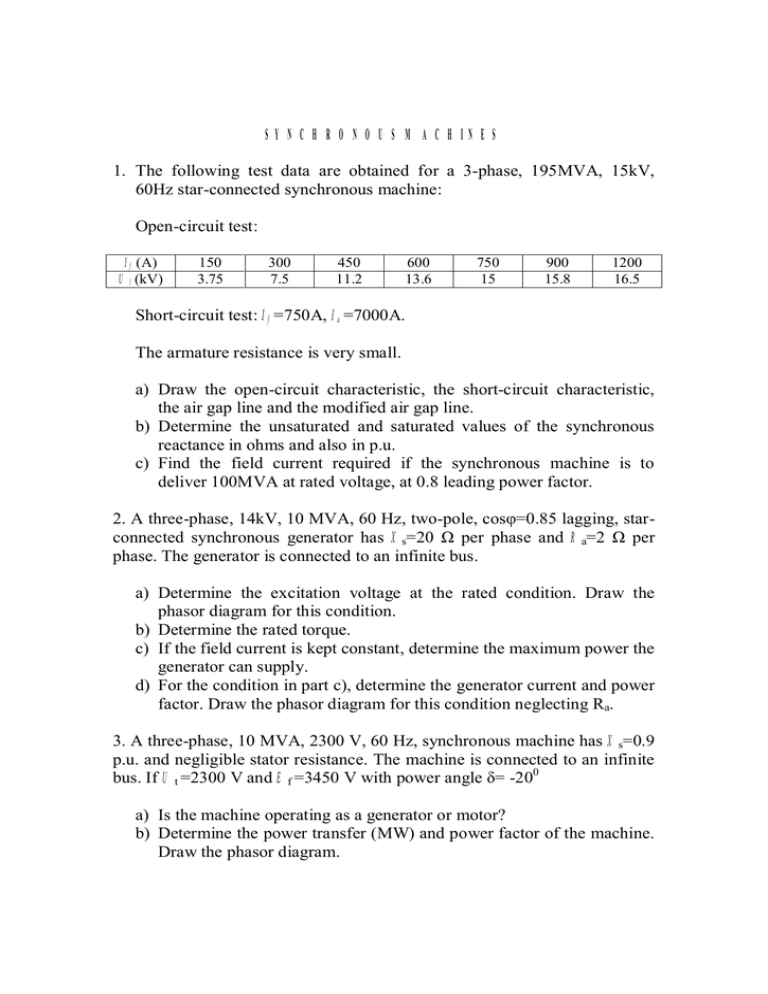
SYNCHRONOUS MACHINES 1. The following test data are obtained for a 3-phase, 195MVA, 15kV, 60Hz star-connected synchronous machine: Open-circuit test: If (A) Ul (kV) 150 3.75 300 7.5 450 11.2 600 13.6 750 15 900 15.8 1200 16.5 Short-circuit test: If =750A, Ia=7000A. The armature resistance is very small. a) Draw the open-circuit characteristic, the short-circuit characteristic, the air gap line and the modified air gap line. b) Determine the unsaturated and saturated values of the synchronous reactance in ohms and also in p.u. c) Find the field current required if the synchronous machine is to deliver 100MVA at rated voltage, at 0.8 leading power factor. 2. A three-phase, 14kV, 10 MVA, 60 Hz, two-pole, cos =0.85 lagging, starconnected synchronous generator has Xs=20 per phase and Ra=2 per phase. The generator is connected to an infinite bus. a) Determine the excitation voltage at the rated condition. Draw the phasor diagram for this condition. b) Determine the rated torque. c) If the field current is kept constant, determine the maximum power the generator can supply. d) For the condition in part c), determine the generator current and power factor. Draw the phasor diagram for this condition neglecting Ra. 3. A three-phase, 10 MVA, 2300 V, 60 Hz, synchronous machine has Xs=0.9 p.u. and negligible stator resistance. The machine is connected to an infinite bus. If Ut =2300 V and Ef =3450 V with power angle = -200 a) Is the machine operating as a generator or motor? b) Determine the power transfer (MW) and power factor of the machine. Draw the phasor diagram. SYNCHRONOUS MACHINES (2) 4. A 1MVA, three-phase, 2300 V, 60Hz, 10 pole, star-connected cylindricalrotor synchronous motor is connected to an infinite bus. The synchronous reactance is 0.8 p.u. All losses may be neglected. The synchronous motor delivers 746 kW and the motor operates at 0.85 power factor leading. a) Determine the excitation voltage Ef. b) Determine the maximum power and torque the motor can deliver for the excitation current for part a), c) The power output is kept constant at 746 kW and the field current is decreased. By what factor can the field current of part a) be reduced before the synchronism is lost? 5. A three-phase, 100 MVA, 12 kV, 60 Hz salient pole synchronous generator has Xd=1.0 p.u., Xq=0.7 p.u. and negligible stator resistance. The machine is connected to an infinite bus and delivers 72 MW at 0.9 power factor lagging. a) Determine the excitation voltage and the power angle. Draw the phasor diagram with Ut as reference. b) Determine the maximum power the synchronous generator can supply if the field current is zero. Determine the machine current and power factor for this condition. Draw the phasor diagram. 6. A three-phase salient pole synchronous machine has reactances Xd=1.2 p.u. and Xq=0.6 p.u. Neglect armature resistance losses. a) The machine operates as a synchronous motor and draws 0.8 p.u. of power at a power factor of 0.8 leading. Determine the power angle and the excitation voltage Ef and draw the phasor diagram. Determine the power due to excitation and that due to saliency of the machine. b) The machine operates as a synchronous generator and delivers 0.8 p.u. of power at the power factor of 0.8 leading. Determine the excitation voltage Ef and the power angle .



